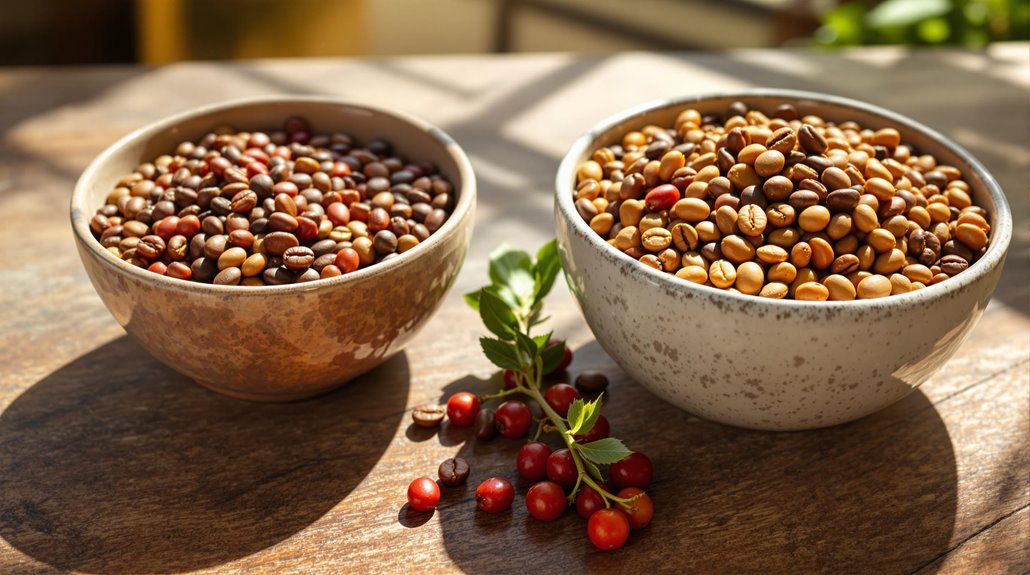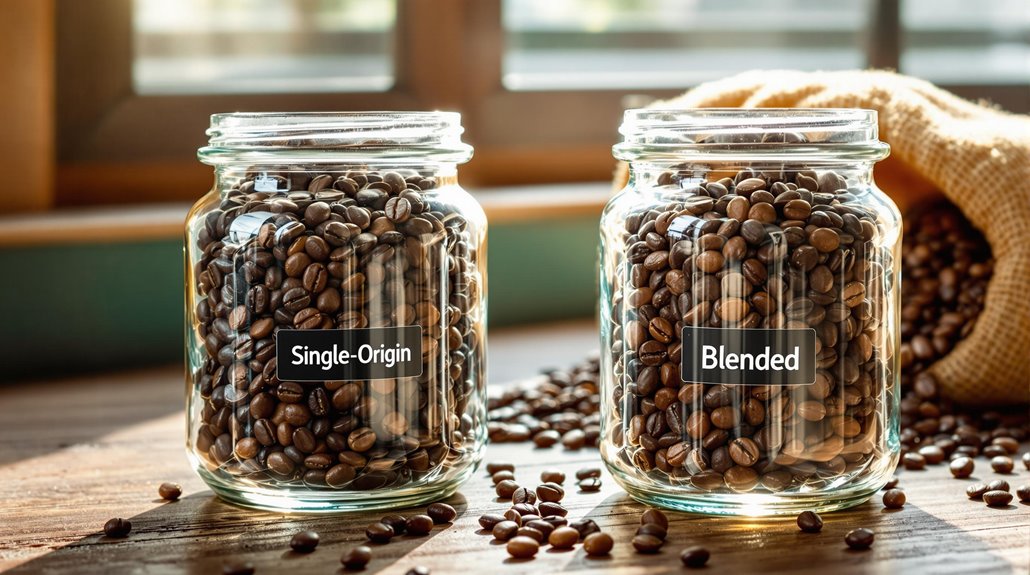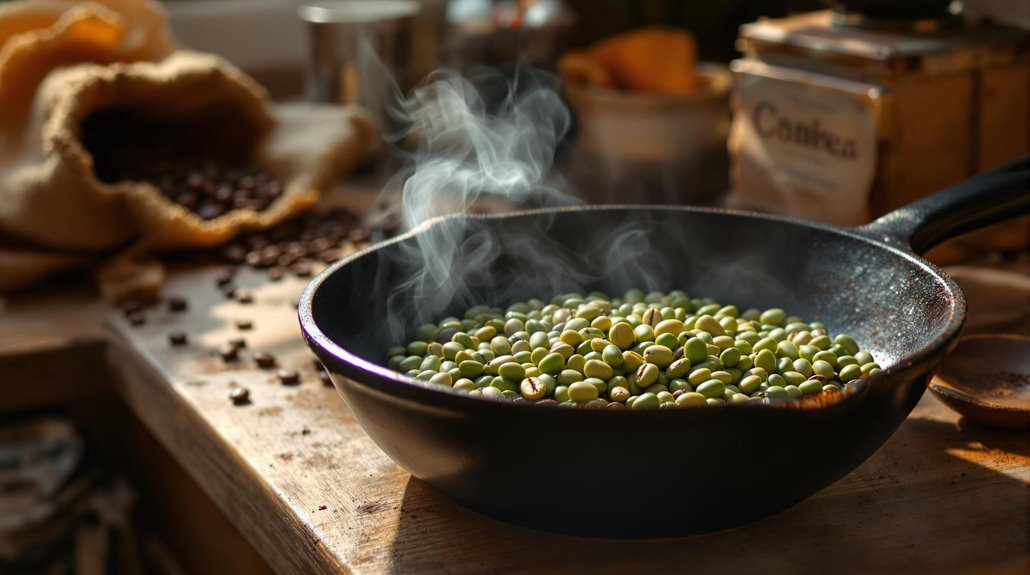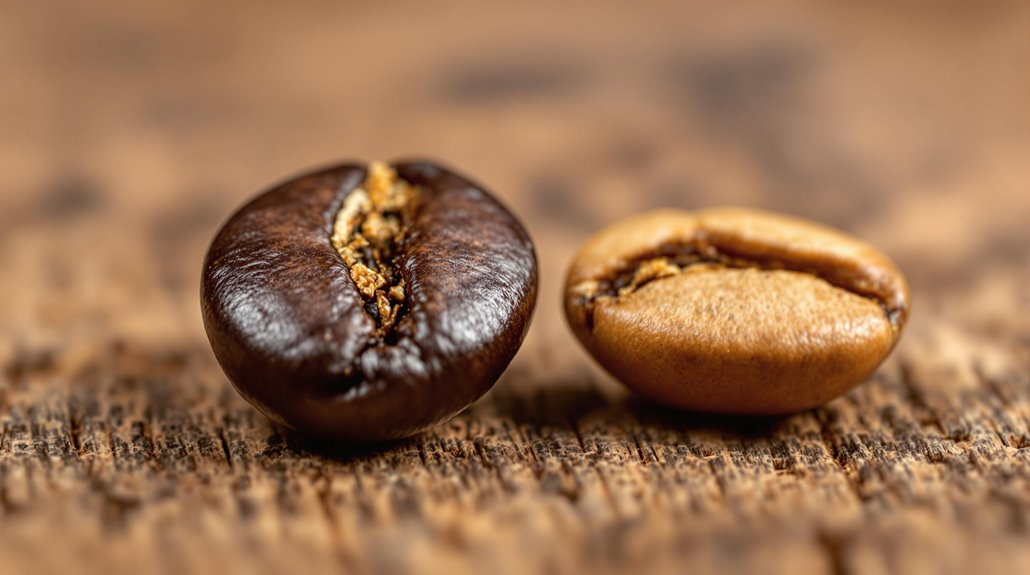







Imagine a painter using a single pigment to create a masterpiece—its purity and uniqueness shine through, much like single-origin coffee beans. These beans come from one region, capturing the essence of their terroir in every sip. On the other hand, blended coffee is like a symphony, combining beans from multiple origins to achieve balance and consistency. But how do these differences affect your morning cup? Whether you crave the distinct character of single-origin or the harmonious complexity of a blend, understanding their nuances can transform how you experience coffee. The choice isn't just about taste—it's about what you value most.
Key Takeaways
- Single-origin coffee comes from one specific region, offering unique, terroir-driven flavors, while blended coffee combines beans from multiple regions for balanced, consistent taste.
- Single-origin coffee highlights distinct flavor profiles (e.g., fruity, floral) best enjoyed black, whereas blended coffee excels in versatility, especially for espresso or milk-based drinks.
- Blended coffee is crafted for year-round consistency, while single-origin coffee reflects seasonal variations tied to specific harvests and growing conditions.
- Blended coffee pairs well with milk or cream, maintaining flavor integrity, while single-origin coffee often loses its nuanced flavors when mixed with milk.
- Single-origin coffee emphasizes purity and traceability, while blended coffee focuses on achieving harmony and complexity through complementary bean characteristics.
Defining Single-Origin Coffee Beans
Single-origin coffee beans are sourced exclusively from one specific geographic location, whether it's a single farm, region, or country. When you choose single origin coffees, you're selecting beans that reflect the unique characteristics of their origin, shaped by factors like soil composition, altitude, and microclimate. These elements combine to create distinct flavor profiles—think bright citrus notes from Ethiopian Yirgacheffe or rich chocolate undertones from Colombian Huila. The precision in growing and processing guarantees that each batch retains its terroir-driven identity, offering a pure expression of its source.
Roasters often highlight single origin coffees for their transparency, labeling them with details like the farm or cooperative where they were grown. This traceability allows you to appreciate the craftsmanship behind each cup. Small-batch harvesting and processing further preserve the beans' unique characteristics, securing consistency and quality. When roasted with care, single origin coffees reveal layers of complexity, from floral and fruity to nutty and earthy tones. By focusing on the origin, you're not just drinking coffee—you're experiencing the story of a specific place, one sip at a time.
Understanding Blended Coffee Beans

Blended coffee beans combine beans from multiple regions to craft a balanced and consistent flavor profile tailored to specific brewing methods. Roasters carefully select beans with complementary characteristics—like acidity, body, and sweetness—to achieve a harmonious taste that remains stable year-round. This precision in blending guarantees versatility, making it ideal for espresso-based drinks or pairing with milk.
Definition and Purpose
Combining beans from diverse regions, blended coffee beans are crafted to achieve a harmonious and balanced flavor profile. Coffee blends are designed to deliver a consistent taste experience, making them a reliable choice for both casual drinkers and coffee enthusiasts. By blending beans with complementary characteristics, roasters create a flavor profile that balances acidity, body, and sweetness, often appealing to a broad audience. This precision in blending guarantees that each cup maintains a familiar and well-rounded taste, even across different batches. Blends are particularly suited for espresso-based drinks, as their balanced nature complements additions like milk or cream. The purpose of blending isn't just to mask flaws but to elevate the overall experience by combining the best attributes of each bean. Whether you're seeking a smooth, approachable cup or a complex yet harmonious brew, coffee blends offer versatility and consistency that single-origin beans may not always provide. Through careful selection and roasting, blended coffee achieves a "platonic coffee ideal," delivering a dependable and satisfying flavor profile every time.
Flavor Profile Creation
Creating a balanced and consistent flavor profile in blended coffee beans requires meticulous attention to detail and a deep understanding of each bean's inherent qualities. When blending multiple beans, you're combining origins with complementary characteristics—like acidity, body, and sweetness—to craft a harmonious cup. Roasters experiment with ratios, roast levels, and processing methods to achieve specific notes, such as chocolatey, nutty, or fruity undertones. For example, natural-process Ethiopian beans often add syrupy texture and bright fruitiness to blends like Blue Bottle's Giant Steps. The goal is to create a consistent product that appeals to a broad audience, offering versatility for espresso-based drinks or milk pairings. Unlike single-origin coffees, which highlight unique regional traits, blends are designed to balance flavors, ensuring a well-rounded experience. Precision in roasting is key, as it reveals the potential of each bean while maintaining the blend's integrity. By mastering these techniques, you can deliver a reliable flavour profile that stands up to added ingredients, making blended coffee a go-to choice for both casual drinkers and connoisseurs.
Flavor Profiles: Single-Origin Vs Blends

Highlighting the distinct characteristics of single-origin and blended coffee, the flavor profiles of each cater to different preferences and brewing styles. Single-origin coffee showcases the unique terroir of its specific region, offering exotic and nuanced flavors like fruity, floral, or herbal notes. For example, Ethiopian beans often deliver bright, berry-like acidity, while Colombian varieties might feature caramel sweetness. These profiles are tied to precise growing conditions, making single-origin coffee ideal for those seeking purity and complexity in their cup.
In contrast, blended coffee combines beans from multiple origins to achieve a balanced and consistent flavor profile. Roasters craft blends to highlight complementary characteristics, such as chocolatey, nutty, or spicy tones, ensuring a harmonious taste year-round. Blends are designed for versatility, often pairing well with milk or cream, making them a crowd-pleasing choice for espresso-based drinks.
Your preference depends on whether you value the unique, terroir-driven nuances of single-origin coffee or the balanced, approachable flavors of blended coffee. Single-origin shines when brewed black, while blends excel in creating a consistent, adaptable experience. Both options reflect the artistry of roasting precision and flavor profiling.
Purity and Consistency in Coffee Types

Single-origin coffee emphasizes purity, delivering a flavor profile that's directly tied to its specific growing region. When you choose single origins, you're tasting the unaltered essence of a particular terroir, with notes shaped by soil, altitude, and climate. This purity allows you to experience the unique characteristics of a region, whether it's the bright acidity of Ethiopian beans or the chocolatey depth of Colombian varieties. However, consistency in single origins can vary slightly due to seasonal changes, as weather and harvest conditions influence each crop.
Blends, on the other hand, prioritize consistency by combining beans from multiple origins. Roasters craft blends to achieve a balanced and uniform flavor, ensuring that each cup tastes the same regardless of yearly variations. This makes blends ideal if you seek a reliable, predictable coffee experience. While single origins highlight the distinctiveness of their origin, blends focus on harmony, blending complementary flavors to create a well-rounded profile. Whether you value purity or consistency, understanding these differences helps you choose the coffee that aligns with your preferences.
Brewing Methods for Single-Origin and Blends

The brewing method you choose can substantially influence the flavor profile of your coffee, whether it's a single-origin or a blend. For single-origin coffees, methods like pour-over or AeroPress are ideal, as they highlight the unique, region-specific characteristics of the coffee beans. These methods allow you to control variables like water temperature and extraction time, ensuring the nuanced flavors of single-origin beans shine. A smaller dose of around 22 g of coffee beans works best for single-origin brews, emphasizing their complexity without overpowering the palate.
Blended coffees, on the other hand, excel in espresso machines due to their balanced flavor profiles and ability to withstand high-pressure extraction. For pour-over brewing, blends benefit from a tighter water-to-coffee ratio—typically 28-30 g of coffee beans to 350 g of water—to achieve a bolder, more consistent taste. Stovetop or plunger methods also work well with blends, delivering robust and even flavors across different brewing techniques. By matching your brewing method to the type of coffee beans, you'll maximize the potential of both single-origin and blended coffees.
Seasonal Availability of Coffee Beans

You'll notice single-origin beans are tied to specific harvest timing, which varies by region and creates limited seasonal offerings. These beans capture the unique terroir and flavor nuances of a particular harvest, making them highly sought after for their freshness and distinct profiles. In contrast, blends are crafted to balance flavors year-round, ensuring consistency regardless of seasonal variations in individual origins.
Harvest Timing Variations
Harvest timing plays a pivotal role in shaping the flavor and availability of coffee beans, with single-origin and blended varieties each responding differently to seasonal cycles. Single-origin beans are harvested during specific windows, reflecting the unique terroir and climate of their region. This seasonal availability means you'll experience distinct flavor profiles tied to the harvest period, such as bright acidity or floral notes in spring harvests or deeper, earthier tones in autumn crops. Roasters often highlight these nuances to showcase the bean's peak freshness and origin-specific characteristics.
In contrast, blended coffee beans combine harvests from multiple regions, ensuring year-round availability and a consistent flavor profile. By sourcing beans from areas with staggered harvest times, blenders mitigate seasonal fluctuations, maintaining a steady supply. This approach allows for precise control over flavor balance, as roasters can adjust ratios to achieve a uniform taste regardless of the season. While single-origin beans offer a snapshot of a specific harvest, blends provide reliability, making them ideal for those seeking a dependable cup. Understanding these harvest timing variations helps you appreciate how seasonal availability influences both the uniqueness and consistency of your coffee experience.
Limited Seasonal Offerings
Why do single-origin coffee beans often feel like a fleeting indulgence? Their seasonal availability ties directly to the harvest period of their specific region, creating a limited window to experience their unique flavor profiles. Unlike blends, which combine beans from multiple regions to guarantee year-round consistency, single-origin coffee beans reflect the distinct characteristics of a single harvest. This means you'll encounter flavors shaped by that year's weather, soil, and processing methods, offering a snapshot of a specific time and place.
Roasters must work with precision to highlight these nuances, often adjusting their techniques to complement the bean's natural qualities. However, this also means that once the harvest period ends, those beans may disappear until the next season. Weather conditions can further impact availability, making certain single-origin offerings even more exclusive. If you're drawn to the complexity and terroir-driven flavors of single-origin coffee, you'll need to act quickly when they're in season. Blends, on the other hand, provide a reliable, year-round option, but they lack the fleeting, harvest-specific charm that makes single-origin beans so special.
Pairing Coffee With Milk and Cream

When pairing coffee with milk or cream, it's essential to think about how the flavors and textures interact. A well-crafted coffee blend combines beans with complementary profiles, guaranteeing the final cup maintains its integrity even when mixed with milk or cream. For example, an espresso blend is specifically designed to balance acidity, body, and sweetness, making it ideal for milk-based drinks like lattes or cappuccinos. The roasting precision in these blends guarantees they don't lose their robust character when paired with dairy.
Cream adds a velvety texture that enhances the smoothness of a blend, while milk alternatives like oat or almond milk can amplify sweetness and create a creamy mouthfeel. Single-origin coffees, on the other hand, often lose their nuanced flavors when combined with milk, making them less suitable for such pairings. Blends, however, are engineered to harmonize with milk or cream, offering a consistent and satisfying experience. Whether you're crafting a classic latte or experimenting with plant-based options, a thoughtfully designed coffee blend guarantees the flavors remain balanced and enjoyable.
History and Evolution of Coffee Blends

You'll find the origins of coffee blends in the 17th century with Mocha-Java, a mix of Yemeni and Indonesian beans that balanced fruity acidity with earthy depth. By the 18th century, European coffeehouses refined blending techniques to create consistent, crowd-pleasing profiles, while the 20th century saw a shift toward mass-market blends, often sacrificing quality. Today, modern blends focus on precision roasting and sourcing to achieve versatility, especially for espresso, while maintaining the balance and complexity pioneered centuries ago.
Origins of Coffee Blends
The origins of coffee blends trace back to the 17th century with the creation of Mocha-Java, a pioneering combination of Yemeni Mocha and Indonesian Java beans. This early blend showcased the potential of combining beans with distinct flavor profiles—Yemeni Mocha's fruity, wine-like notes paired with Java's earthy, full-bodied character. Blends VS Single origins became a defining choice as European coffeehouses in the 18th century sought to craft consistent, crowd-pleasing flavors. By blending beans from different regions, roasters could balance acidity, body, and aroma, creating a harmonious profile that single origins couldn't always achieve alone.
The 20th century saw a decline in blend quality with the rise of pre-ground coffee, but Italian espresso blends stood out for their precision in roasting and blending. In the 1960s, Peets Coffee revived high-quality blends by sourcing Direct Trade Coffee, emphasizing well-grown, acidic beans roasted to perfection. Today, modern blends continue to prioritize balance and consistency, often combining beans from multiple regions to create a unified flavor experience. Whether you prefer Blends VS Single origins, understanding their origins helps you appreciate the craftsmanship behind each cup.
Early Blend Innovations
Early blend innovations began with the groundbreaking Mocha-Java combination in the 17th century, marking the first intentional pairing of distinct coffee origins. This blend combined the fruity, wine-like notes of Yemeni Mocha with the earthy, full-bodied profile of Indonesian Java, creating a balanced and complex cup. By the 18th century, European coffeehouses capitalized on this concept, crafting blends to attract customers with unique and consistent flavor profiles. These early blends showcased how different types of coffee could complement each other, enhancing acidity, body, or sweetness.
In the 20th century, the rise of pre-ground coffee led to a decline in blend quality, as mass production prioritized convenience over flavor. However, Italian espresso blends stood out, maintaining high standards by carefully selecting and roasting beans to achieve rich, crema-topped shots. The specialty coffee movement in the 1960s, led by pioneers like Peets Coffee, revived the art of blending. They sourced high-quality, acidic beans and roasted them with precision, proving that blends are made to elevate, not dilute, flavor. These innovations laid the foundation for modern blending techniques, emphasizing balance and craftsmanship.
Modern Blend Development
Crafting modern coffee blends involves a meticulous balance of sourcing, roasting, and flavor profiling to achieve a harmonious cup. Coffee roasters carefully select different beans from multiple regions to produce a consistent flavor profile that appeals to a wide audience. By combining beans with complementary characteristics—such as fruity Ethiopian coffees with chocolatey Central American varieties—roasters create blends that highlight complexity while maintaining balance. The rise of espresso in the 20th century further refined blending techniques, as roasters developed recipes tailored for high-pressure brewing methods, ensuring rich crema and bold flavors. Today, specialty coffee roasters often incorporate seasonal single-origin coffees into their blends, adding layers of depth and nuance. Precision in roasting is critical, as each bean type requires specific heat and time adjustments to release its full potential. Modern blends aren't just about consistency; they're designed to evolve, offering drinkers a dynamic experience with every sip. Whether you're seeking a smooth, approachable cup or a bold, espresso-forward blend, the art of blending continues to push boundaries, delivering both reliability and innovation.
Choosing Between Single-Origin and Blends

When deciding between single-origin and blended coffee beans, it's essential to evaluate how each aligns with your flavor preferences and brewing methods. If you're new to brewing, blends or single-origin options can shape your coffee journey. Blends are crafted for consistency, offering a balanced flavor profile that works well with espresso-based drinks or milk pairings. They're ideal if you value reliability and a harmonious cup. Single-origin beans, on the other hand, showcase unique, region-specific flavors influenced by terroir, making them perfect for black coffee where their nuanced notes shine. Coffee lovers seeking adventure often gravitate toward single-origin for its complexity and seasonal variations, though these can also mean less consistency. If you prefer a predictable, comforting cup, blends are your go-to. Consider your brewing style: single-origin excels in pour-over or French press, while blends are versatile for espresso machines. Ultimately, your choice hinges on whether you prioritize exploration or familiarity, with single-origin offering an in-depth exploration into regional characteristics and blends providing a well-rounded, crowd-pleasing experience.
Crafting the Perfect Coffee Blend

Combining beans from diverse regions to achieve a harmonious flavor profile is both an art and a science. You'll often pair acidic Guatemalan beans with mellow Indonesian ones to balance brightness and depth. By blending multiple coffees, you create a profile that's perfectly suited for specific brewing methods, like espresso, where chocolate and nutty notes shine under high-pressure extraction. Experiment with ratios, roast levels, and processing methods—natural-process Ethiopian beans can add syrupy texture, while dark-roasted beans enhance richness and complexity. Precision in roasting guarantees each component contributes to the final cup without overpowering others. Consistency is key; you'll need rigorous quality control and seasonal adjustments to account for variations in bean characteristics. A signature espresso blend, for example, must deliver smooth, balanced flavors batch after batch. Crafting the perfect blend isn't just about mixing beans—it's about understanding how each origin's unique traits interact, creating a symphony of flavors that's greater than the sum of its parts.
Disclosure: As an Amazon Associate, I earn from qualifying purchases.







